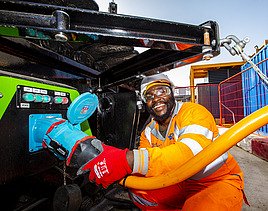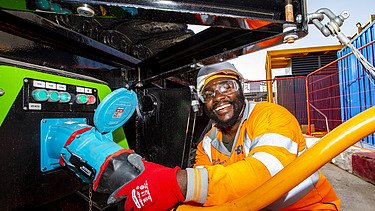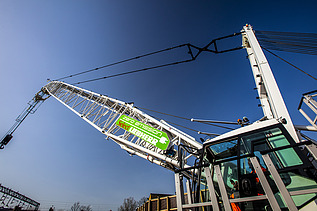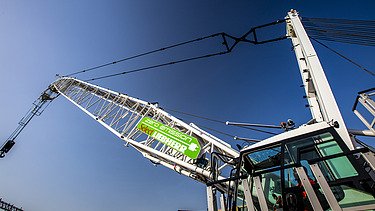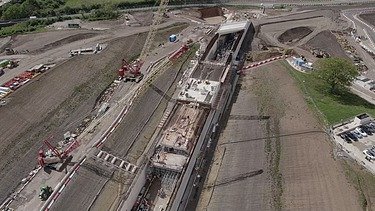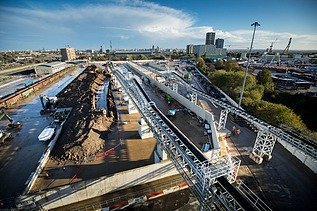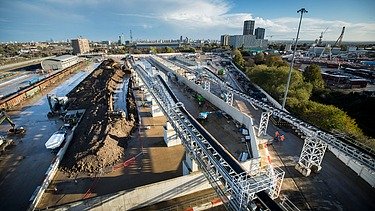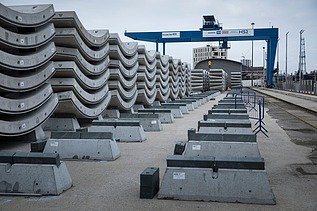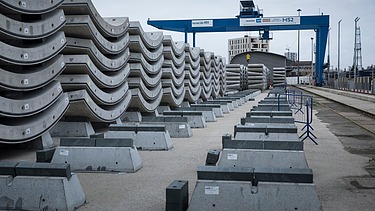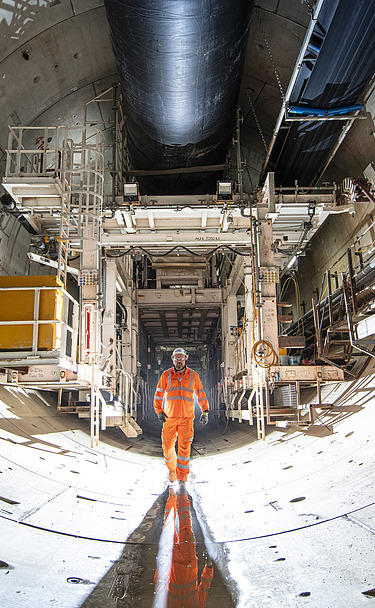
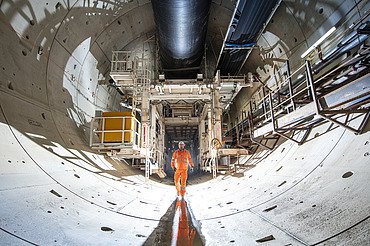
Client:
HS2 Ltd
Location:
London, UK
Build time:
2017 - present
HS2 London Tunnels and Approaches
STRABAG is planning and constructing the London Tunnels and Approaches section of the incredible HS2 megaproject as part of the SCS consortium, a joint venture between Skanska, Costain, and STRABAG (SCS JV).
This involves the construction of 48km of twin-bore tunnels for high-speed railway using tunnel boring machines and multi-discipline civil engineering works with a focus on safe, sustainable, and innovative construction and engineering solutions.
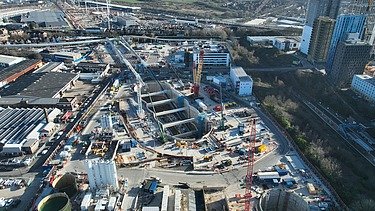
In 2020, construction began on Europe’s largest infrastructure project, HS2 - a high-speed railway, and the first to be built in the UK in over a century.
Shortly after winning the contract in 2017, SCS JV commissioned Design House (a joint venture between STRABAG, Arup, and TYPSA) to complete the design for the project. The success of the joint venture lies in the full integration of all three construction partners with the client, HS2, who is also embedded in the project team.
From the centre of London to the M25 (London’s orbital motorway), 95% of the high-speed line will run through tunnels. It is this that the SCS JV has been tasked with - constructing 13 miles of twin-bore tunnels across 22 sites.
The project spans an impressive 2,535,000 square metres of land, with the 22 sites divided into three key areas:
- West Delivery Unit
- Tunnels and Shafts Delivery Unit
- Euston Delivery Unit
Furthermore, based in Willesden Junction, the Logistics Hub manages the logistics for all 22 sites spanning three key areas, including the movement of materials into SCS sites, the rail solution to receive deliveries of pre-cast tunnel segments and process earth from 42 kilometres of excavated tunnel, and the management of security and sub-contractors.
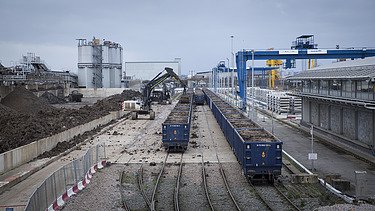
Six tunnel boring machines (TBMs) are building the tunnels between West Ruislip and Old Oak Common station in West London and then on to Euston station in central London. A seventh TBM was used to build a logistics tunnel to support the construction of the Euston Tunnel.
These state-of-the-art TBMs were specially designed with a robotic arm that picks up tunnel segments and inserts them into place, a process that previously involved people. This innovation improves both safety and efficiency within the project.
An innovative, self-travelling, electric platform also allows the first-stage concrete at the base of the tunnel to be installed at the same time as the tunnel drive is taking place. This enables initial track works to be carried out simultaneously with tunnel construction, saving time and improving efficiency.
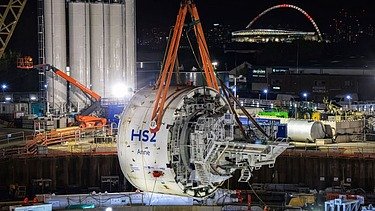
HS2 trains will travel through the 4.5 mile-long Euston Tunnel and arrive at the Euston Approaches tunnels, which will pass underneath the existing railway and where one tunnel will split in two, making three tunnels in total.
A crossover cavern is being constructed due to the significant constraints of the site, where trains can switch tracks underground.
SCS JV is also extending two bridges for the new tracks to pass under. The three tunnels are being built under a 12-metre-high, 150-year-old heritage Victorian retaining wall (The Park Village East Wall). The confinement of the Euston Approaches site and tunnels poses an immense challenge, as it sits between the Park Village East Wall and is three metres away from the existing live railway line.
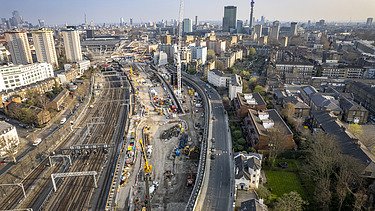
As well as the tunnels, additional structures have been constructed across the project. These include six vent shafts that connect the tunnels to the open air, helping to regulate air quality and temperature, and providing evacuation and access points.
The Victoria Road Crossover Box (VRCB) structure was designed to allow the HS2 trains to switch between tracks when approaching and departing from Old Oak Common station. The innovative approach of building the box in a caterpillar shape instead of a rectangle has reduced the amount of concrete needed by 40% and allows for the transfer of forces around to the props.
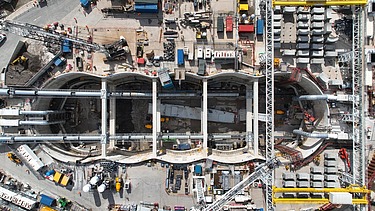
Environment
The STRABAG Sustainability Strategy 2040 sets the ambitious goal of achieving climate neutrality across our entire value chain by 2040. Minimising the impact on the surrounding environment is central to the work of the SCS JV, with several new innovations being developed during the project.
-
Electricity generation
All above-ground machinery is powered by biofuels like hydrotreated vegetable oil and solar.
The Canterbury Works site in South Kilburn introduced one of the UK's first 160-tonne emissions-free fully-electric crawler cranes and an electric compressor. It was the first diesel-free site on the HS2 project and is powered entirely by 100% renewable energy.
These combined efforts help to reduce carbon, improve air quality, and lower noise.
The Euston Approaches team uses the world’s first all-electric high-capacity BAUER drilling rig, reducing noise by 50% and cutting CO₂ by 1,200 kg per day.
Additionally, a tower crane in the Euston Area uses the PUNCH Flybrid ‘flywheel’ energy recovery system, which stores energy to reduce peak demand and cut energy consumption. This innovation won the award for the Carbon Net Zero Initiative of the Year and the overall Initiative of the Year Award at the British Construction Industry Awards 2022. -
Green tunnel innovation
The West Delivery Unit is home to the 900-metre Copthall Tunnel, a green tunnel built using the cut-and-cover method, where soil and vegetation are placed over the structure for natural integration into the landscape.
Excavated material from the TBMs is used to cover the tunnel, reducing the carbon footprint and impact on the local community.
Additionally, two sustainable areas have been created from the excavated earth, with 70,000 trees and plants to form a public park and return land for farming. -
Spoil removal
A 2.7km conveyor system has been built over rail bridges, roads, and canals to transport excavated material from Old Oak Common station to the Logistics Hub, where it is loaded onto trains for transport out of London, reducing traffic and CO2 emissions.
The excavated material is then transported via rail to parts of England such as Cambridgeshire, Kent, and Rugby, where it is used to fill quarries and create new nature reserves.
A specialist logistics tunnel between the Logistics Hub and Old Oak Common station has been built to transport materials for the construction of the Euston Tunnel, avoiding local roads and minimising disruption to work at Old Oak Common station. -
Logistics Hub
The Logistics Hub team has introduced several innovations to address challenges in metropolitan areas.
An automatic number plate recognition (ANPR) network with nearly 200 cameras monitors HGV movements across 17 approved routes, allowing the team to verify compliance within 90 seconds of arrival.
Digitised driver inductions enable contact with HGV drivers before they reach the sites. Additionally, an AI-enabled mud camera alerts the control room if mud is tracked onto local roads, ensuring quick clean-up and improved safety.
